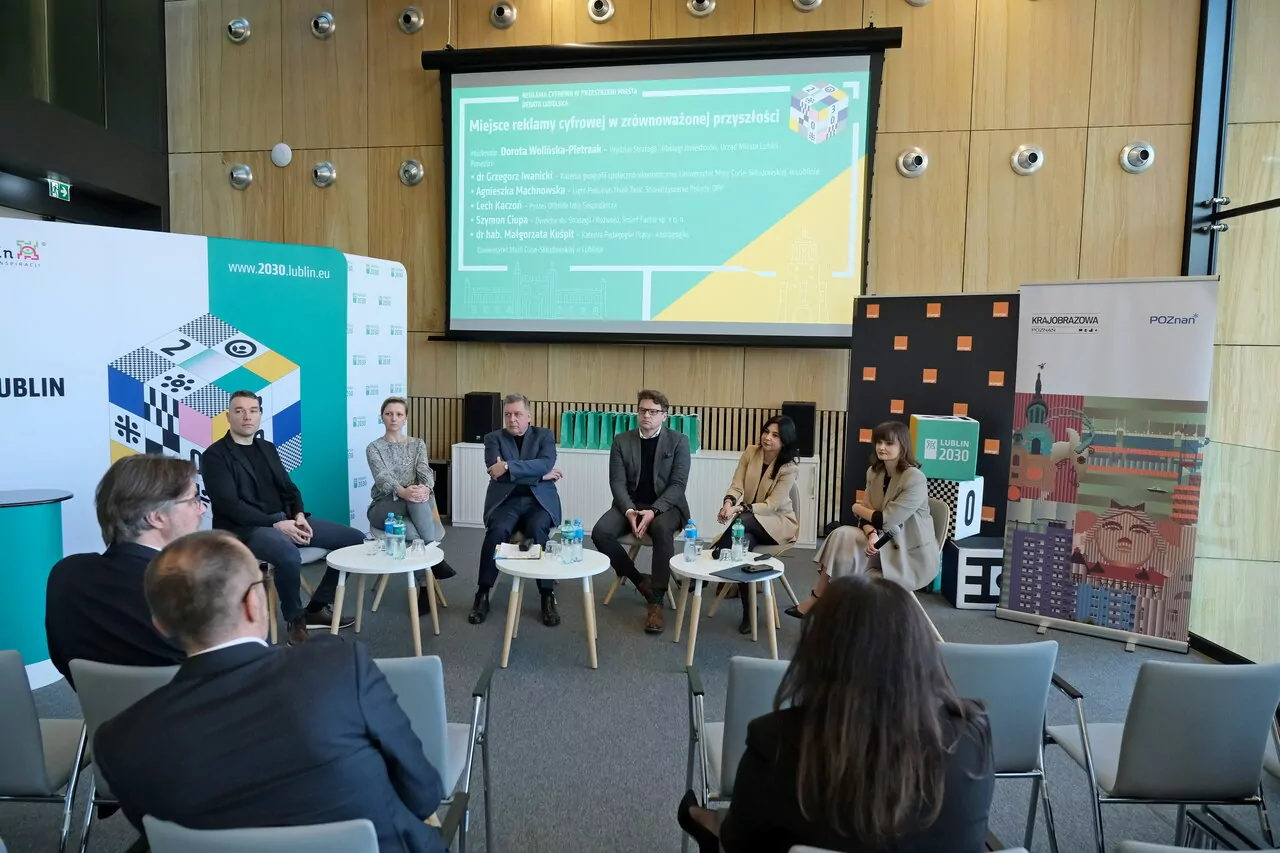Lublin Info Centre
Lublin debate “Digital advertising in the city space” behind us

Yesterday, the Lublin Debate brought together stakeholders from local government, business, and academia to discuss the evolving role of digital advertising in urban spaces. The discussion addressed its impact on city aesthetics, residents’ well-being, and the environment. It was a dynamic exchange of ideas, resulting in several actionable insights that can guide future decisions.
- Digital Out of Home – the business perspective.
During this session, participants discussed the latest technologies shaping how brands communicate with consumers. The discussion also explored the future of digital advertising in the context of evolving consumer expectations and growing awareness of digital engagement.

- The role of digital advertising in a sustainable future.
Experts from various fields examined how digital advertising influences cities, impacting their aesthetics, biodiversity, and overall quality of life, including safety. The discussion addressed corporate social responsibility in responding to these challenges and explore methods to minimize the negative impact of digital advertising on daily life.

- Tools and the scope of city influence on the DOOH market – the local government perspective.
This panel focused on the fundamental question: what is the role of cities in managing digital advertising? With the increasing presence of advertising in public spaces, it was crucial to understand the capabilities and tools cities have to effectively regulate this dynamic sector. The panel also identified gaps in the legal system that might hinder this process.

The discussion provided a valuable platform for participants to share experiences and ideas, co-creating a vision for managing digital advertising in ways that balance the interests of residents with urban development goals. Below are the key insights and recommendations that emerged:
- Digital advertising is inevitable in modern cities, but it requires clear and precise regulation. Standards should be established for size, location, brightness, and operating hours to prevent chaotic placement and its negative effects on residents, urban aesthetics, and the environment.
- Advertisements should be zoned – located where they are needed and expected, such as commercial areas, while being excluded from sensitive spaces such as parks, schools, historic sites, and residential neighborhoods.
- Vulnerable groups, such as children with autism spectrum disorders, need to be protected from the negative effects of bright lights and dynamic visuals. Detailed research should be conducted to develop specific guidelines for manufacturers of digital advertisements, enabling them to adjust parameters like brightness and movement to accommodate the needs of these individuals. High-intensity advertisements should not be placed in sensitive areas, such as near schools or therapeutic facilities.
- Digital advertising should not be treated as an afterthought. Its integration into urban spaces must be considered at the planning stage of new developments and building designs. This proactive approach would enable advertisements to harmonize with the urban environment and help avoid unnecessary visual clutter.
- Despite the rapid expansion of digital formats, traditional advertising still holds a place in the urban landscape. Increasingly, it is taking on more artistic and creative forms, such as Coca-Cola’s greenery-themed campaign or Tymbark’s use of bottle caps integrated into the urban setting. These examples show that advertising can be more than just a tool for selling—it can inspire, delight, and enhance urban spaces when designed thoughtfully.
- Environmental concerns need to be addressed. Bright, illuminated screens can disrupt the natural cycles of wildlife, including birds and insects. Digital advertisements should be powered by renewable energy, with brightness and operating hours adjusted to minimize harm to ecosystems.
- Local governments adopt various approaches to managing advertisements, utilizing Landscape Resolutions tailored to local conditions and creating Cultural Parks within their municipalities. However, it must be acknowledged that these tools are not perfect, and discussions among multiple stakeholders are necessary to develop their most optimal forms.
- Enforcing compliance with local advertising regulations poses a challenge for local governments, where modern technologies, including the so-called digital twin, can be of assistance.
- While social media offers an alternative platform for advertising, it cannot fully replace physical ads. Not everyone uses social media, and physical advertising remains an essential communication tool that must be thoughtfully managed and designed to fit the urban landscape.
- The debate underscored the importance of managing advertising in a way that respects residents’ needs, protects the environment, and enhances urban aesthetics.
A big thank you to all participants for your valuable insights and contributions, and to all guests for your active participation and thought-provoking ideas. We look forward to continuing this discussion and already invite you to join the next debate in 𝗠𝗮𝗿𝗰𝗵 𝟮𝟬𝟮𝟱, this time hosted by the the City of Warsaw Municipal Office. Stay tuned for more details
The debate was the second event dedicated to the future of digital advertising in cities. The first Poznań Debate, titled “The Future of Digital Advertising in Urban Space,” took place on September 20 and was hosted by the Department of Urban Planning and Architecture of the Poznań City Hall.






